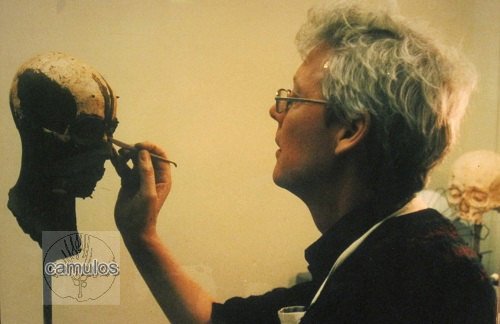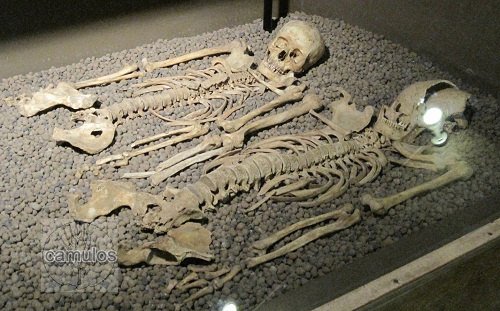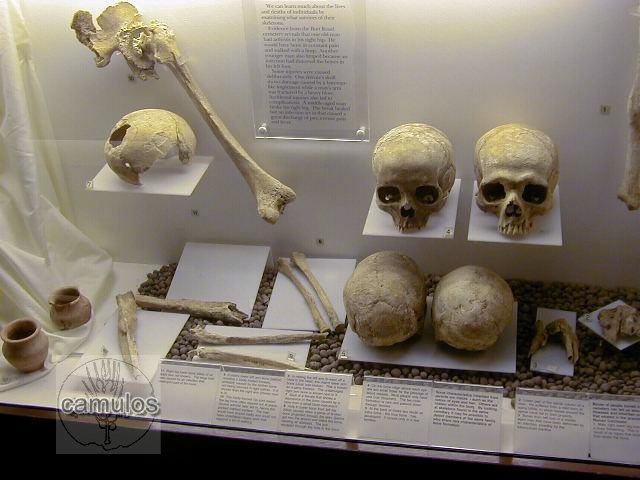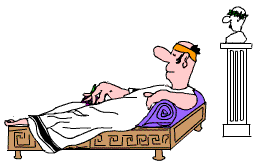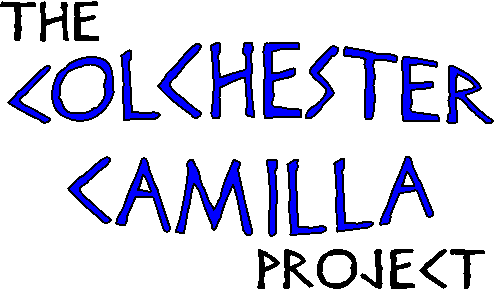
THE COLCHESTER CAMILLA PROJECT The Colchester Camilla Project is a new, DNA based, geographical project for modern day people who have a direct paternal or maternal ancestral line originating in or around the English town of Colchester in the county of Essex. It is aiming to show a genetic link with the DNA taken from human remains of people who lived in or around Colchester during the Romano-British period (43AD to 410AD). The only requirement for joining the project is that participants should have a family connection with the Essex area.
We would then like people to take a DNA test (on the direct paternal line for the Y-DNA test or on the direct maternal line for the mtDNA test) to show where they fit in with the ancient DNA of Roman period Colchester inhabitants. We separately hope that it will eventually be possible to build up a picture of the genetic composition of the people of the Colchester area and to discover more about their ancestral origins.
Colchester is the oldest recorded town in Britain and it is where British civilisation began. It is where the Roman invaders came to take the surrender of eleven British tribal chiefs in the year 43AD, making Colchester, for a time, the capital of Britain. Before that time the Trinovantes, the richest and most powerful tribe in Britain, lived here. It was here too that, it is believed, the Celtic-Belgic people had come and who had taken eventual control of the indigenous British people of this area of Britain. After the death of their leader, Cunobelin, probably the most powerful of all British chieftains, the Romans saw an opportunity to invade. The Trinovantes were subdued and governed by the Romans. Their descendants would undoubtedly have been amongst those thousands of people that modern day archaeologists have discovered buried in huge graveyards mainly to the south of the Roman town (or colonia) of Colchester (or Camulodunum in early times).
How will this be reflected by DNA analysis? Did the Romans leave a genetic legacy in Colchester? Were the Romans buried in the same cemeteries as the British people? Hundreds of skeletons have been uncovered and some DNA testing has been done. It is hoped that the project will eventually provide answers to some of these questions.
So, we are seeking people to join this project - people who have a family history that can be traced back 300 or so years to Colchester, where we assume, an ancient DNA (aDNA) link is more likely to be found. Freemen of the town are sought especially. We also seek specialists who are able to carry out mitochondrial DNA Testing of ancient teeth and/or bones. There is no shortage of specimens!
The value of the project will grow over time as more people join and more results are available for comparison.
Please join us on our journey of ancient genetic discovery.
Please learn more at our website at:
The search for a true Colchester man or woman?
By true, we mean, does your ancestry trace back many centuries in the Colchester area - even possibly to the time of the Roman occupation of Britain.
Many people in Colchester and, for that matter, across the whole world are quite likely to have just such a connection; but how to prove it? In theory, it should be quite an easy matter in this modern day to compare our genetic make up through our DNA, with that of the DNA taken from graves of centuries ago. In the 1980s and 90s, a Roman period (AD43 to 410) graveyard at Butt Road was excavated as part of the work being done to build our new police station. During that excavation, hundreds of graves were uncovered and a project was started to investigate family connections of those that had been buried there, using DNA testing methods.
In 2011, exactly 1600 years after the Romans left these shores to go fight battles elsewhere, local historian Jess Jephcott contacted his local newspaper, The Essex County Standard, to ask whether they could publicise details of an embryonic project that would try to find a genetic link between skeleton remains uncovered at Butt Road and with modern day people. This they were pleased to do and the result was a huge amount of interest from mainly local people who could trace their family coinnections back to the Colchester area, over many decades or centuries.
For at least 300 years, Colchester has conferred the 'Freedom of the Borough' to people of Colchester whose ancestors have lived and worked in the town. This has proved to be a good source of likely candidates for people who might have descended from earliest times. All that we need to do is prove it!
CAMILLA
A group of interested persons met with museum staff in January 2011 to 'meet the ancestors'; two of hundreds of Roman period skeletons found at the Butt Road cemetery during an archaeological excavation. It is assumed that the two people were husband and wife, due to the way they were laid together. The skull of the female went on to be used to create a model of how experts believed she would once have looked. She was given the name of Camilla, as this seemed a suitable name for a citizen of Camulodunum. But was she British or was she Roman?
The museum has hundreds of skeletal remains in its collection from the Colchester's Roman period. Some of these display genetically inherited features that suggest family plots in burial areas. But whether British people were buried in the same areas as Romans or other native races, is not known. Only DNA tests would show this.
Above: Camilla, on the left, and her presumed husband, who lay side by side in the cemetery. His skull showed that he had survived a severe head wound at some time during his life.
Some remains in the Castle Museum, some with evidence of medical problems.
There was a study done in the 1990s to extract DNA from the remains of skeletons, but this was inconclusive. It looks as if we need to carry out further ancient DNA testing, using up to date, and highly specialised methods that will, hopefully, give us, what is known as, a haplogroup. Haplogroups refer to deep ancestral origins dating back thousands of years and, in human genetics, the haplogroups most commonly studied are Y chromosome and mitochondrial DNA, both of which can be used to define genetic populations. Y-DNA is passed solely along the father to son line, whilst mtDNA is passed down the maternal line, from mother to offspring of both sexes. The mtDNA is likely to be the answer to this projects, as Y-DNA exists in much lower quantity.
So, whilst it is an easy matter to determine the haplogroup of our modern day volunteers by a simple mouth swab, it is of little use to this project without corresponding haplogroup information from our Roman or Iron Age British ancestors. We have made contact with various other groups who have already done similar studies, specifically the 7th century BC 'Cheddar Man' study and various Viking studies in the north of England and Scotland. So we must wait a while until we can find the answers to these key questions and before we can report that we have true 'Colchester Man' alive and well and still living in Colchester.
Family historians can often trace their family trees back around 10 generations, with a generation being around 30 years. That would take them to the year 1700. If that family tree takes them to the north east Essex area, it is quite probable that the family had been in the area for may years before that. However the 60 generations that are needed would take us back 1800 years to Roman times and cannot be followed by written documentation. DNA is the only way open to us. Anybody in the world can take a DNA test to try and find a connection to Colchester Man, but the most likely connection will probably be found with somebody whose ancestors came from this area. Surnames can also be a clue to this. So, this project is open to everybody.
You may not find that you are descended from Colchester Man, but your DNA result will not be wasted. It will certainly tell you something about your distant ancestry and may even link in with another DNA project. One of our candidates has already had a test done and this is what he was able to tell us'
'Some years ago I had my paternal DNA tested by the Genographic Project, run by the National Geographic. The results show that my Y chromosome DNA (father to son) belongs to the haplogroup E1b1b1(M35). This is quite unusual as only 4-5% of British men belong to this haplogroup, as opposed to 20% of men in Sicily and Greece, 13% in Italy and 10% in Spain. As my family obviously has Mediterranean origins.... !' If you would like to become a part of this project by having a DNA test done, please contact Jess Jephcott at the email address given below. COST
We have decided to use the services of a company known as Family Tree DNA (FTDNA). For males, we are recommending Y-DNA37+mtDNAPlus and for females we are recommending mtFullSequence. For each test the cost is $299 US (approx. £185.00), although special offers of 40% or so are frequently offered, bring the cost down to around £115. Less detailed tests can be done at reduced cost but their usefulness to this sort of project is limited.
Please visit their website at www.familytreedna.com.
The cost of aDNA tests (the ancient DNA) is something that will need to be decided, with the possibility of grant funding being an option. This is under consideration at present. The Y chromosome DNA testing done in 1990's was inconclusive and suffered from possible contamination of the bone samples through handling and washing. Mitochondrial DNA is sourced through teeth, which does not suffer from the contamination problems due to the hardness of the tooth enamel.
LINKS
Roman remains from Butt Road Cemetery, Colchester, Essex, England
Patricia Smith. "The Secrets of the Romano-Britons' genes: New data from old bones". The Colchester Archaeologist, Number 11, 1998, 18-19.
Nina Crummy, Philip Crummy and Carl Cross. Excavations of Roman and later cemeteries, churches and monastic sites in Colchester, 1971-88 (46 megabytes)
|
